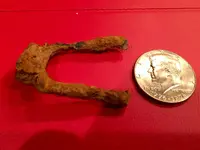An explosive object's fragmentation radius can be measured accurately only if the object is stationary when it explodes. Cannonballs were typically 10-to-20 feet in the air AND traveling at about 700+ miles per hour when they exploded. Therefore, the fragmentation radius is greatly distorted, having the shape of a very long oval instead of a circle. For example, the fragments at the "back side" of the cannonball actually get slowed down by the explosion, because it blows them "backwards"... and the frags at the front side get a boost to their speed, being "accelerated" by the explosion.
Callicles is correct... the amount of gunpowder (the "bursting charge") inside the cannonball affected how far the fragments would get blown. According to US and CS civl war Ordnance Department specifications, a 12-Pounder caliber Case-Shot shell contained a 1-ounce bursting charge (and about 90 antipersonnel balls). The specification for a 12-Pounder caliber Common-Shell (the type Joe73 found) was a 6-ounce bursting charge. Six times more powder would of course cause a much wider fragmentation radius.
Also, keep in mind that explosive cannonballs had a "time-fuze," and worked imperfectly. (A civil war era artillery time-fuze resembled a piece of a cigarette, and was basicly an oversized firecracker fuze.) The time-fuze could be "cut" to explode the shell after (just as an example) 6 seconds of flight, but in actual use their performance varied. Many would detonate the shell at 6 seconds but some would be a bit shorter and some a bit longer. That variability has the effect of spreading the fragments from several shots over quite a wide area.
 And, please keep us informed about what you find.
And, please keep us informed about what you find.
